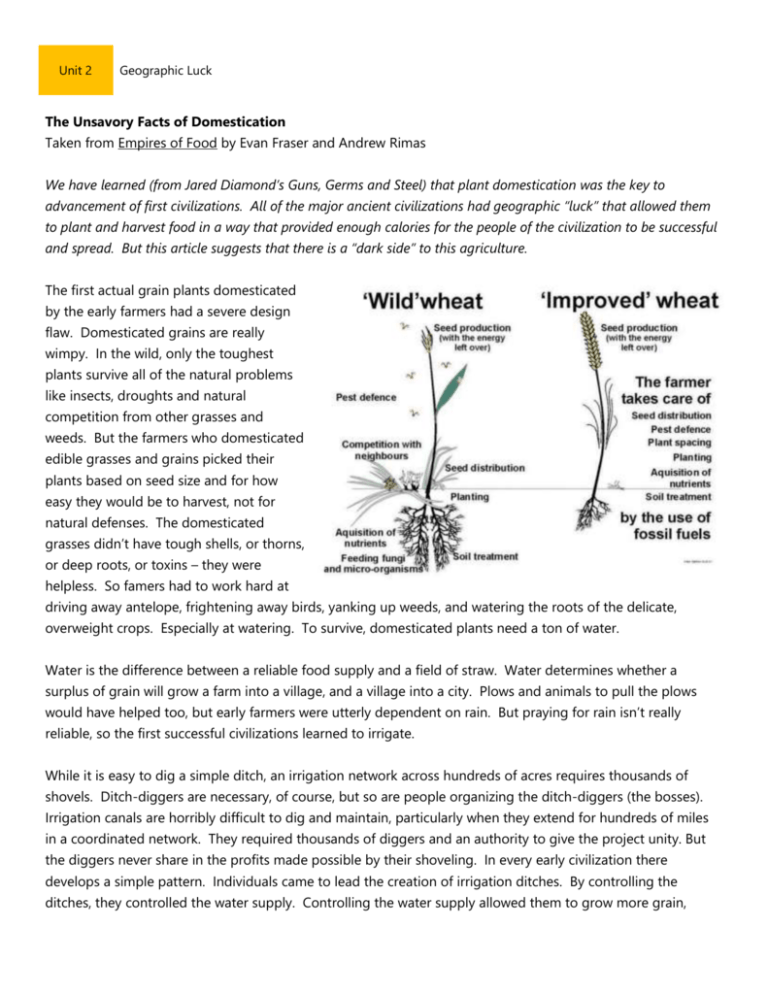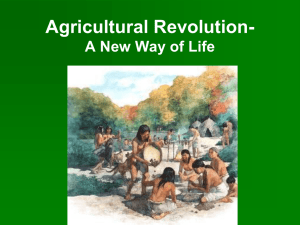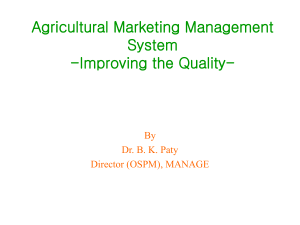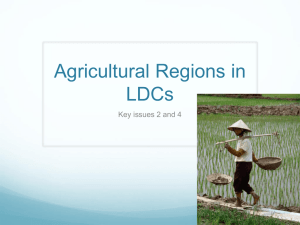Geographic Luck
advertisement

Unit 2 Geographic Luck The Unsavory Facts of Domestication Taken from Empires of Food by Evan Fraser and Andrew Rimas We have learned (from Jared Diamond’s Guns, Germs and Steel) that plant domestication was the key to advancement of first civilizations. All of the major ancient civilizations had geographic “luck” that allowed them to plant and harvest food in a way that provided enough calories for the people of the civilization to be successful and spread. But this article suggests that there is a “dark side” to this agriculture. The first actual grain plants domesticated by the early farmers had a severe design flaw. Domesticated grains are really wimpy. In the wild, only the toughest plants survive all of the natural problems like insects, droughts and natural competition from other grasses and weeds. But the farmers who domesticated edible grasses and grains picked their plants based on seed size and for how easy they would be to harvest, not for natural defenses. The domesticated grasses didn’t have tough shells, or thorns, or deep roots, or toxins – they were helpless. So famers had to work hard at driving away antelope, frightening away birds, yanking up weeds, and watering the roots of the delicate, overweight crops. Especially at watering. To survive, domesticated plants need a ton of water. Water is the difference between a reliable food supply and a field of straw. Water determines whether a surplus of grain will grow a farm into a village, and a village into a city. Plows and animals to pull the plows would have helped too, but early farmers were utterly dependent on rain. But praying for rain isn’t really reliable, so the first successful civilizations learned to irrigate. While it is easy to dig a simple ditch, an irrigation network across hundreds of acres requires thousands of shovels. Ditch-diggers are necessary, of course, but so are people organizing the ditch-diggers (the bosses). Irrigation canals are horribly difficult to dig and maintain, particularly when they extend for hundreds of miles in a coordinated network. They required thousands of diggers and an authority to give the project unity. But the diggers never share in the profits made possible by their shoveling. In every early civilization there develops a simple pattern. Individuals came to lead the creation of irrigation ditches. By controlling the ditches, they controlled the water supply. Controlling the water supply allowed them to grow more grain, Unit 2 Geographic Luck which they traded for more and more individual wealth. The wealthy elites then had to continue the cycle to gain more wealth. They had to force the diggers to do their jobs. The nature of agriculture is no fun. The invention of farming and urban civilization didn’t improve the daily lives of most human beings – actually, it shortened lifespans, inflicted chronic malnutrition, caused diseases to start and fester, and condemned nearly the entire population to forced work. Farming a light subsistence crop and hunting the odd gazelle would have surely been more attractive to the average person thousands of years ago (and probably today too). Archeologists have proven that nearly every early agricultural center suffered a plunge in the quality of diet as the farmers switched from fresh meat and vegetables to gruel made from the seeds from grass plants. Apart from the lack of taste, the new menu caused tooth decay – no small problem in an age of no dentists. Also, most grain crops are missing some important nutrient. Corn, or maize, lacks essential amino acids, will millet and wheat lack iron. Rice has no protein. Bodies that don’t have enough protein can’t process Vitamin A, so many Asian farmers lost their eyesight. The agricultural revolution also stunted children’s growth rates. AN analysis of ancient bones from early farming sites show declines in bone length and density over the periods where farming took root. Huntergather skeletons are far larger and healthier than those skeletons from settled farmers. It has only been in recent history (since the 1800s and Industrial Revolution) that we have regained our height and strength from our ancestors of 10,000 years ago. Diseases like tuberculosis were also part of the new lifestyle. Farmers lived in cramped rooms that lacked fresh air, and many also lived in the same spaces as their livestock. The actual farming ground away the laborers’ joints and mangled their backs. Worst of all, while hunter-gatherers worked an average of 20 hours a week feeding themselves, farmers had to work for 40 to 60 hours. Another of agriculture’s curses was warfare. Our earliest acts of organized violence might well have been undertaken in the name of feeding hungry families, perhaps in a village where the crops failed but the farming tools were sharp. Farmers are more willing to join gangs and commit organized murder than huntergatherers. This may be partly because grain surpluses are incentive for war as well as a resource for fighting it- soldiers Unit 2 Geographic Luck need feeding, and they can’t fight when they are hunting elk and bison. Farmers are already organized and used to discipline, two things necessary for making good soldiers. Also, famers can never turn the other cheek if a neighbor starts a fight, since their whole existence is in their land. When hunter-gatherers are faced with a fight, they have the option to walk away to a distant more peaceful place to look for berries and wild animals. Agriculturalists might fight to the death to protect their harvest. If they don’t, starvation and certain death awaits. Finally, while the first farmers probably didn’t invent sexism, they did institutionalize it. Historians think that in most hunter-gatherer societies, food was gathered rather than hunted, meaning that most of the food was collected by the women. Women’s role as primary food provider gave them status, and since no one owned much more than a few strips of leather or flint, men (with weapons) weren’t needed much to fight over property. There wasn’t really anyone to fight, since hunter-gatherer groups usually kept their numbers in check through infanticide (killing of infants) and long years of breast-feeding (women have difficulty conceiving a new child while they are breast-feeding an existing one). The hunter-gatherers knew what would happen if too many people hunted the same land – the animals would die off too soon and their whole group would die off as well. Around 10,000 BCE the big animals began to disappear from the human menu, and women’s work became even more important for survival. The hunter-gatherer men – underemployed due to a lack of mammoth, learned to trade rather than farm. Women farmed, men traded, which gave men an avenue to make a new economic mark in society, while women remained in their ancient role. Agriculture may well have been an early step in the tradition of male prejudice against women. So why did our ancestors choose to live the miserable existence of farming? They probably had no choice. The early tribes that learned farming first were able to feed more babies. Over a few generations their offspring outnumbered the children of their neighbors. As the farmers picked weeds and killed or domesticated the local wildlife, the land changed. It became softer, more receptive to farming. Another reason people took up farming is because the weather made them do it. Until 8000 BCE, the Fertile Crescent was too cold for successful farming. A few centuries of humid rainfall made the land sprout. Populations grew. But when the rain moved away again and the ground turned brown, the tribes all wondered to the same damp land, looking to take control of it. The resources that were easy to obtain weren’t enough to feed everyone, so people went to the riverbanks and settled down there. They became sedentary. The foundations of law, wealth (and poverty) and government had been set. Human beings had learned to sit still. There was no going back. Once the farms bloomed into cities, social inequality was created. In the ancient civilizations, like in China and Sargon, king of a region of Mesopotamia called Akkad Unit 2 Geographic Luck Sumer, a permanent majority of the people were poor, they prepared the fields and repaired the irrigation canals. They supported a tiny group of wealthy citizens. While hunter-gatherers had a state of (mostly) equality, famers had kings. Oppression didn’t happen immediately. The earliest known city, Catal Huyuk, in what is now modern day Turkey, had homes that were more or less identical. If they had political leaders, they were no better than anyone else. But that changed with agriculture surpluses. The Fertile Crescent at its peak was a land of palaces and slums. Some were born and were treated as living gods, but most were slaves. The same thing happened in India, China, Egypt and eventually the Americas. Agricultural surpluses – stable wealth – eventually leads to the creation of absolute monarchy.








